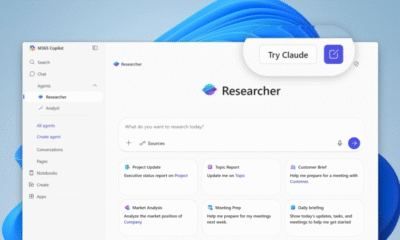Tech News
Embracing the Future: Shadow AI and the Evolution of Work

The Rise of Shadow AI: A Growing Challenge for Enterprises
Internal AI applications within organizations are failing to meet the expectations of employees, leading to the increasing dominance of shadow AI. Despite 92% of companies planning to increase their AI investments, only 21% of office workers believe that AI apps significantly enhance their productivity. This 71% gap between expectations and reality is pushing more businesses to reevaluate the employee experiences provided by their internally developed apps.
Vineet Arora, CTO at WinWire, emphasized the importance of usability in enterprise AI adoption. He highlighted that the lack of intuitive AI tools leads to low adoption rates and the emergence of shadow AI applications. Employees creating shadow AI apps are not intentionally causing harm but are driven by the need to manage complex workloads, time constraints, and tight deadlines.
Itamar Golan, CEO of Prompt Security, recently acquired by SentinelOne, shared insights on the proliferation of shadow AI apps, with around 40% of these apps utilizing data without proper authorization, posing risks to intellectual property.
The Disconnect Between Expectations and Reality
Research from Ivanti reveals a significant gap between employee expectations for AI applications and their actual delivery. Employees across various industries are finding innovative ways to leverage AI for efficiency, leading to the risk of data exposure through unauthorized AI usage.
Legacy UI Approaches and the Proliferation of Shadow AI
Legacy approaches to UI design are fueling the growth of shadow AI. Employees compare enterprise AI tools to consumer-grade applications, often finding enterprise solutions less intuitive. This disparity in user experience drives employees to seek alternative AI solutions, resulting in the rise of shadow AI.
The increasing use of shadow AI poses significant security risks, with breaches involving unauthorized AI tools costing organizations millions of dollars. Enterprises need to focus on improving user experience to prevent the proliferation of shadow AI.
The Productivity Paradox and the Role of AI Usability
Enterprises are losing millions of dollars annually due to poor UI design, leading to decreased productivity and employees resorting to personal AI tools. Improving AI usability and enhancing the employee experience are crucial in addressing the productivity paradox and reducing the reliance on shadow AI.
Addressing the Shadow AI Challenge
Organizations need to adopt strategies to tackle the proliferation of shadow AI while prioritizing user experience. Key steps include auditing unauthorized AI usage, centralizing AI governance, monitoring user pain points, maintaining a catalog of approved AI tools, providing targeted AI training, and deploying enterprise-grade AI solutions that meet user expectations.
By focusing on enhancing user experience and addressing the root causes of shadow AI, organizations can mitigate security risks and improve productivity. It is essential to treat UI and UX design as critical security controls and ensure that AI applications are intuitive and user-friendly.
-

 Facebook5 days ago
Facebook5 days agoWarning: Facebook Creators Face Monetization Loss for Stealing and Reposting Videos
-

 Facebook5 days ago
Facebook5 days agoFacebook Compliance: ICE-tracking Page Removed After US Government Intervention
-

 Facebook5 days ago
Facebook5 days agoInstaDub: Meta’s AI Translation Tool for Instagram Videos
-

 Facebook5 days ago
Facebook5 days agoBreaking Updates: Meta Connect 2025 Unveils Latest Developments
-

 Video Games6 days ago
Video Games6 days agoGoku Takes on the Dragon Ball FighterZ Arena
-

 Cars5 days ago
Cars5 days agoRevving into the Future: Ferrari’s Plan to Unleash 20 New Models, Including Electric Vehicles, by 2030
-

 Video Games6 days ago
Video Games6 days agoTekken 8: Rise of the Shadows
-

 Microsoft5 days ago
Microsoft5 days agoMicrosoft Integrates Anthropic’s Claude AI Models into 365 Copilot: A Deepening Relationship with OpenAI






























